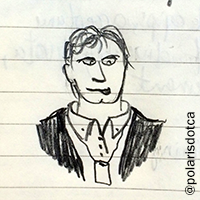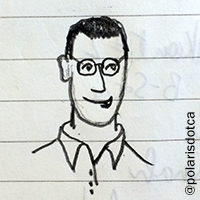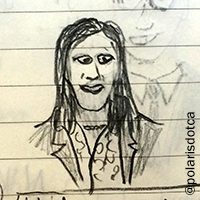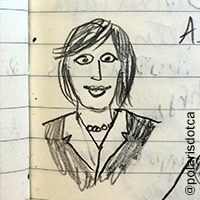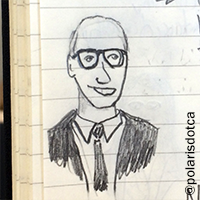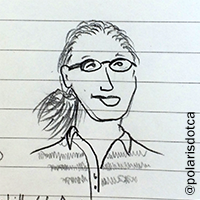I spent April 24, 2015, in two half-day presentations led by David R. Brown in the Division of Undergraduate Education at the National Science Foundation. Special thanks to my colleague Stacey Bridges for organizing these events.
The first presentation, Dave outlined how the NSF supports innovation in undergraduate science, technology, engineering, math (STEM) education. It was a blizzard of acronyms which Dave patiently translated for us, always with a smile and a twinkle in his eye. One slide, for example, was about
NSF DUE SBIR/STTR Phase IICC
At that stage, it was all traxoline to me.
To summarize what happened in the presentation: the NSF is a complicated organization that funds billions of dollars of research ($7.2 billion this year) including research in undergraduate STEM education.
If you’re looking for a grant to study undergraduate STEM education, you should find your way to the IUSE grants (the evolution of STEP, TUES, and WIDER grants), deep within the NSF:
Improving Undergraduate STEM Education (IUSE)
grant from the
Division for Undergraduate Education (DUE)
in the
Directorate for Education and Human Resources (EHR)
at the
National Science Foundation (NSF)
Writing a Successful DUE Proposal
The afternoon session with Dave was full of advice for writing successful education grant proposals. He had three key messages:
First, the best professional development you can get to help you write successful grants is volunteer to be a grant reviewer.
Second, and I’ll quote Dave:
In order to maximize potential for award, follow the Program Solicitation and Grant Proposal Guide (GPG) with highest fidelity (or face RWR: return without review.)
Third, every grant writer should read and align their proposal with these 11 landmark works.
1. PCAST Report: Engage to Excel
 The President’s Council of Advisors on Science and Technology (PCAST) forecasts “a need for producing, over the next decade, approximately 1 million more college graduates in STEM fields” and makes 5 recommendations for reaching this goal:
The President’s Council of Advisors on Science and Technology (PCAST) forecasts “a need for producing, over the next decade, approximately 1 million more college graduates in STEM fields” and makes 5 recommendations for reaching this goal:
- catalyze widespread adoption of empirically validated teaching practices;
- advocate and provide support for replacing standard laboratory courses with discovery-based research courses;
- launch a national experiment in post secondary mathematics education to address the mathematics preparation gap;
- encourage partnerships among stakeholders to diversify pathways to STEM careers; and
- create a Presidential Council on STEM Education with leadership from the academic and business communities to provide strategic leadership for transformative and sustainable change in STEM undergraduate education.
Source: look for full report plus an executive summary by finding the 2012 “Undergraduate STEM Education Report” at the PCAST Documents and Reports.
2. CoSTEM 5-Year Strategic Plan
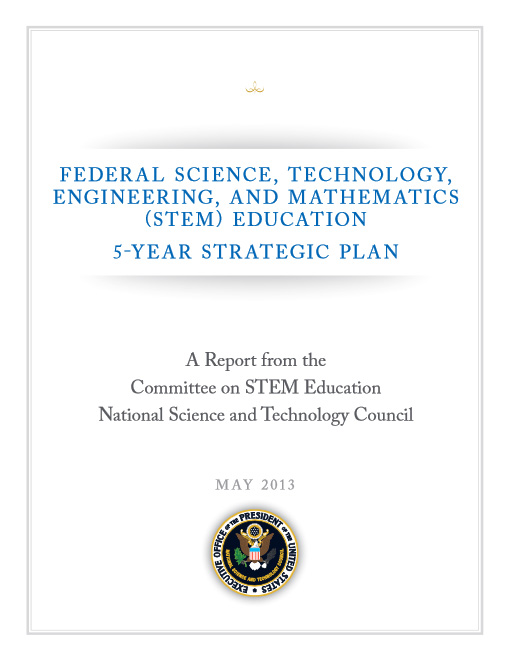 In May, 2013, the Committee on STEM Education (CoSTEM) within the National Science and Technology Council released, “Federal Science, Technology, Engineering, and Mathematics (STEM) Education 5-Year Strategic Plan.” The report recommends 5 areas for STEM Education investment:
In May, 2013, the Committee on STEM Education (CoSTEM) within the National Science and Technology Council released, “Federal Science, Technology, Engineering, and Mathematics (STEM) Education 5-Year Strategic Plan.” The report recommends 5 areas for STEM Education investment:
- Improve STEM instruction.
- Increase and sustain youth and public engagement in STEM.
- Enhance the STEM experience of undergraduates.
- Better serve groups historically underrepresented in STEM.
- Design graduate education for tomorrow’s STEM workforce.
Source: Look for the full Federal STEM Strategic Plan at the Office of Science and Technology Policy.
3. DBER Report
 In 2012, the National Research Council published the Discipline-Based Education Research (DBER) Report. It describes how each of the STEM disciplines can address 3 key issues:
In 2012, the National Research Council published the Discipline-Based Education Research (DBER) Report. It describes how each of the STEM disciplines can address 3 key issues:
- Student-centered learning strategies can enhance learning more than traditional lectures.
- Students have incorrect understandings about fundamental concepts.
- Students are challenged by important aspect of the domain that can seem easy or obvious to experts.
Source: download a copy of the DBER Report or read it online through the National Academies Press.
 4. Reaching Students by Nancy Kober (2015)
4. Reaching Students by Nancy Kober (2015)
Dave calls this a “Follow-up to DBER Report for Practitioners” and a “How-to guide for DBER”. At the CIRTL Forum in April 2015, Myles Boylan, Lead Program Director at the NSF DUE, highlighted this report, too.
Source: download a copy of Reaching Students or read it online through the National Academies Press.
5. “The Similarities Between Research in Education and Research in the Hard Sciences” by Carl Wieman
Carl Wieman is a Nobel-prize winning physicist who’s spend the last decade researching how undergraduates learn and how to train instructors to design and teach active classes using evidence-based practices. The Carl Wieman Science Education Initiative at the University of British Columbia is a fantastic resources for teaching and learning in higher education. (Full disclosure – I spent 5 years working at UBC in the CWSEI before going to the University of California, San Diego. That experience continues to be the foundation of my work.) Carl also spent time in the Office of Science and Technology Policy (OSTP), the organization responsible for the PCAST Report.
Source: Wieman, C. (2014). The Similarities Between Research in Education and Research in the Hard Sciences. Educational Researcher 43 (1), pp. 12-14. doi: 10.3102/0013189X13520294
6. “Active learning increases student performance in science, engineering, and mathematics” by Freeman et al.

This landmark paper by Freeman et al. describes a meta-analysis of 225 published studies that measured student performance in traditional lecture vs. active learning classrooms. The evidence is overwhelming that active classes are more effective. As the authors put it, if this was a medical study where students in active classrooms were given an experimental treatment with the traditional, lecture-based classrooms as the control, they’d stop the study and give everybody the experimental treatment. Wired blogger Aatish Bhatia wrote a great summary of the paper and Carl Wieman published a short commentary.
Source: Freeman, S., Eddy, S.L., Miles McDonough, M., Smith, M.K., Okoroafor, N., Jordt, H., & Wenderoth, M.P. (2014). Active learning increases student performance in science, engineering, and mathematics. PNAS 2014 111 (23) 8410-8415. doi:10.1073/pnas.1319030111
7. Describing & Measuring Undergraduate STEM Teaching Practices (2013)

The book is the result of a AAAS/NSF meeting that drew participants from nearly 50 institutions to identify tools and techniques that can be used in describing teaching practices. It discusses five techniques that individuals or organizations can use to measure STEM teaching: faculty and student surveys, interviews, classroom observations and teaching portfolios. The best descriptions of STEM teaching typically involve the use of multiple techniques, the book concludes. (source)
Source: You can get a PDF from the meeting website (follow the “Describing and Measuring Teaching Practices” link)
8. Project Evaluation
 This “User-Friendly Handbook” covers
This “User-Friendly Handbook” covers
- Evaluation and Types of Evaluations
- Steps in the Evaluation Process
- An Overview of Quantitative and Qualitative Data Collection Methods
- Strategies That Address Culturally Responsive Evaluation
Source: Section by section PDFs and a PDF of the entire 2002 document are available here. There’s a 2010 edition (PDF), too, but Dave didn’t mention it.
9. Center on Education and the Workforce at Georgetown University
The PCAST report, recall, calls for 1 million more college graduates in STEM fields. Not 1 million more faculty, researchers, graduate students, and postdocs but on undergraduates who will graduate and then do what? Join the workforce. The NSF is interested in funding projects that help these undergraduates prepare for those careers. These 2 reports from the Center for Education of the Workforce are resources for education researchers less familiar with life outside the ivory towers of academia.
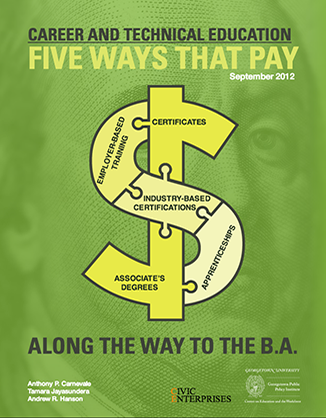 |
 |
|---|
Source: Five Ways That Pay Along the Way to the B.A. by A.P. Carnevale, T. Jayasundera, & A.R. Hanson (2012). STEM by Anthony P. Carnevale, Nicole Smith, and Michelle Melton (2011).
10. Community Colleges in the Evolving STEM Landscape
 Remember, the PCAST calls for an additional 1 million college graduates, not university graduates. Those of us in R1 institutions can’t forget that the teaching and learning research we carry out (ideally, with NSF support) has to be applicable to teaching and learning in 2- and 4-year colleges, too. What does that mean? How are colleges different than universities? Are there any differences in the students? These questions and more are addressed in this report prepared by Steve Olson and Jay B. Labov.
Remember, the PCAST calls for an additional 1 million college graduates, not university graduates. Those of us in R1 institutions can’t forget that the teaching and learning research we carry out (ideally, with NSF support) has to be applicable to teaching and learning in 2- and 4-year colleges, too. What does that mean? How are colleges different than universities? Are there any differences in the students? These questions and more are addressed in this report prepared by Steve Olson and Jay B. Labov.
Source: Like the DBER report, this report is published by the National Academies Press and is available online in HTML and PDF.
11. Common Guidelines for Education Research and Development (2013)
 (Not to be confused with NSF Grant Proposal Guide (GPG). These guidelines were developed by the representatives from the Institute of Educational Sciences in the U.S. Department of Education and from the NSF. As Dave puts it, it offers guidance on building the evidence base in STEM learning, including
(Not to be confused with NSF Grant Proposal Guide (GPG). These guidelines were developed by the representatives from the Institute of Educational Sciences in the U.S. Department of Education and from the NSF. As Dave puts it, it offers guidance on building the evidence base in STEM learning, including
- guidelines intended to improve the quality, coherence, and pace of knowledge development in STEM education
- guidance intended for program officers, prospective grantees, and peer reviewers
- it is not intended to be prescriptive or exhaustive
For various types of research and development, from those contributing core knowledge to those assessing implementation of interventions, the Common Guidelines describe the
- Purpose
- Empirical and theoretical justifications (evidence base)
- Types of project outcomes (evidence generation)
- Quality of evidence
Source: A PDF is available from the NSF. Here’s a FAQ about the Common Guidelines.
Remember, the goal is to align your proposal with these works (or at the very least, don’t contradict them.) Dave recommends putting them all on a USB stick and keeping them handy when writing (or reviewing) NSF DUE proposals. And once more, Dave reminds us, follow the Grant Proposal Guide (GPG) “with highest fidelity.”
Good luck with your grant proposal!






